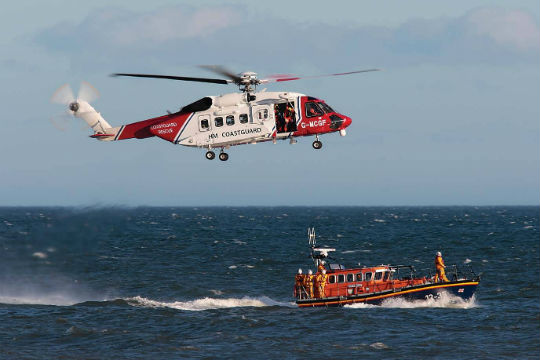
Bristow Helicopters began a 10-year contract to provide search-and-rescue services on behalf of the U.K.’s Maritime and Coastguard Agency in April 2015. Here, a Sikorsky
S-92 holds a hover over a lifeboat off the U.K. coast. Bristow Photo
April 1, 2015, marked a new era in search-and-rescue (SAR) in the United Kingdom. After 70 years of provision by the Royal Navy and Royal Air Force (RAF), most recently with the venerable Westland WS-61 Sea King, the U.K. took the first steps in a two-year process that will eventually see its SAR service delivered entirely by a civilian operator: Bristow Helicopters Ltd.
When the U.K. government awarded Bristow the £1.6 billion ($2.4 billion) contract to provide search-and-rescue on behalf of the Maritime and Coastguard Agency in March 2013, it said the new service would allow new, state-of-the-art helicopters to join the nation’s SAR fleet, and increase the percentage of high and very high risk areas reachable by helicopter within 30 minutes from 70 to 85 percent. However, while Bristow and the U.K. government have been at pains to point out that much of the service will remain the same as that provided by the military — including the taskings being provided by the Aeronautical Rescue Coordination Centre (ARCC), the response times being airborne within 15 minutes during the day and 45 minutes overnight, and crews composing of two pilots, a winch operator, and a winchman — there was some apprehension and skepticism voiced in the mainstream media about the changeover as the transition approached.
Bristow, of course, is no stranger to providing SAR — it currently does so in Norway, Australia, Trinidad and Tobago, the Falkland Islands, and (through its partner, Cougar) in Newfoundland — and has been delivering the service as part of the “Gap SAR” contract for Northern Scotland from Coastguard bases in Sumburgh and Stornoway since June and July 2013, respectively. (This contract continues to 2017, when both bases will transition to the UK SAR contract.) But Bristow’s history of providing SAR in the UK actually reaches back much further — it provided the service at RAF Manston from 1971 to 1974 and then, on behalf of the Coastguard, in Sumburgh, Stornoway, Lee-on-Solent and Portland from 1983 to 2007.
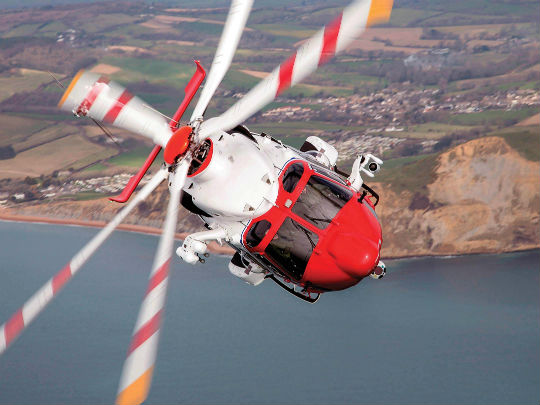
Bristow will eventually service the U.K. SAR contract with 11 Sikorsky S-92s and 11 AgustaWestland AW189s. However, with the AW189 awaiting certification of its full icing protection system, additional S-92s and AgustaWestland AW139s are being used in the interim. AgustaWestland Photo
“I would say that as with any change there’s always a little bit of fear and some skepticism, especially when the military have been providing this service for decades,” Samantha Willenbacher, director of UK search and rescue at Bristow Helicopters, told Vertical. “But I think once people start to understand what our heritage is from a SAR perspective, they start to become a little less concerned, and from a local community point of view, they’re enjoying seeing the red and white Coastguard helicopters we operate, and when the good news of the work that our crews are doing is getting publicized, then it only helps the local communities and the media feel assured that search-and-rescue and the safety of individuals in the United Kingdom is in good hands.”
Another issue of contention has been the reduction of SAR bases in the U.K. (from 12 to 10), but this was a requirement from the Department for Transport, rather than a decision made by the various bidding parties. How the bidders met this requirement — while still serving a mandated radius of action and reaching certain hotspots that had been modeled on decades of data from the military’s historical taskings — was the first puzzle that needed solving.
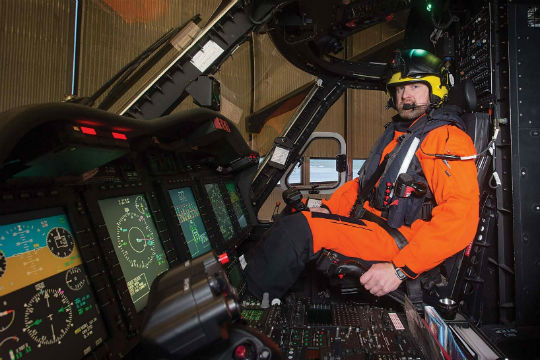
Inside the cockpit of one of the Sikorsky S-92s servicing Bristow’s Gap SAR contract. The aircraft has a host of customizations for the role, including the manufacturer’s SAR autopilot and crew hover function. Bristow Photo
Bristow’s solution was to offer a mixed fleet of 22 aircraft — 11 Sikorsky S-92s and 11 AgustaWestland AW189s (two at each base, plus two extra). “For the bases where we needed a longer range, the S-92 was already well proven,” said Willenbacher. “It was introduced in the northern bases eight years or so ago, and so was a natural choice to meet that requirement; and then as far as what we decided to do for the bases that didn’t have such a range requirement, the 189 — the fact that it was based on the [AW]139 that was also well proven in the SAR role — seemed the natural choice.”
Rolling out the Fleet
The transition from military to civilian provision of SAR in the U.K. has been a gradual one. It began with Inverness (northern and central Scotland) and Humberside (northeast England) on April 1, 2015, and these were followed by Caernarfon (northwest Wales) in July, Lydd (southeast England) in August, and St. Athan (southern Wales) in October. Prestwick (southern Scotland) and Newquay (southwest England) will begin operations in January 2016, with Lee-on-Solent (southern central England), Stornoway (northwest Scotland) and Sumburgh (Shetland Islands) to transition to the new contract in 2017.
In Bristow’s bid, it proposed placing the S-92s in Humberside, Caernarfon, Newquay, Stornoway, and Sumburgh; with the AW189s operating from Inverness, Lydd, St Athan, Prestwick, and Lee-on-Solent. However, if you’ve been following the rollout of civilian SAR in the U.K., you’ll be well aware of the fact that Bristow is not currently using any AW189s in the provision of its service — the three that it has received from AgustaWestland are going through a continued operational evaluation. The reason for the delay is no great secret — Bristow is bound by contractual requirement to provide aircraft that have full icing protection, and as of mid-November 2015, the AW189 had only received certification of its limited ice protection system.
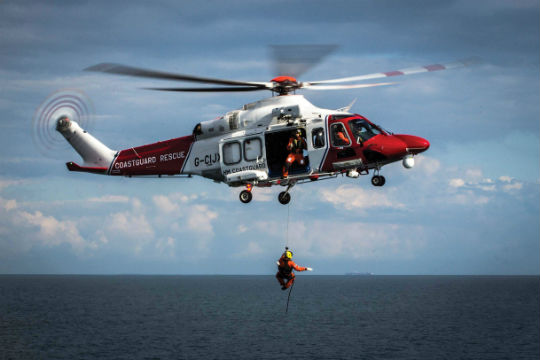
Hoist training with the AW139, performed by the crew from Lydd. The base in Southeast England went live in August, and is using AW139s until the AW189 is ready to enter service. Royal Navy Photo
In the meantime, Bristow is employing AW139s in Lydd and St Athan, and is using the S-92 in Inverness and Prestwick. Willenbacher said Bristow is reviewing when the AW189 will be ready for service, and that AgustaWestland was also addressing a couple of issues in the rear cabin. Rear crew training will begin once these issues have been sorted, but pilot training on the aircraft is ongoing.
In terms of the locations of the bases, Willenbacher said the decision to establish bases outside of military properties was due to uncertainty in the longevity of those locations, while being based at airports would allow Bristow to focus solely on the SAR and helicopter elements of the operation. “We made the decision to go to airports, build brand new facilities, but have the airport be responsible for what they’re expert in, and let us be responsible for the SAR service,” she said.
Each new base represents an investment of approximately £7 million ($10.7 million), and Willenbacher said the first three bases — in Inverness, Humberside, and Caernarfon — have been given a BREEAM rating for sustainable planning, design, and construction. “These buildings are environmentally friendly, with natural light, solar panels, rainwater
harvesting, and tanks that capture the runoff from when we’re washing the aircraft,” she said. “We’ve also made sure that we’ve returned the area around the bases to as close to their previous natural state as possible. That’s included planting a specific type of wildflower in Humberside, and a specific type of grass in Caernarfon.”
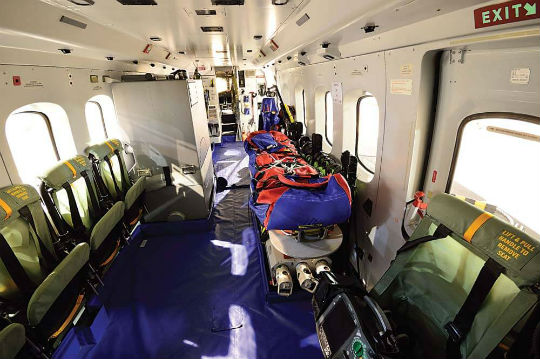
The cabin of one of the Gap SAR S-92s includes stretchers, the observer station, Sea Tray over the floor, and removable passenger seats. Bristow Photo
The same level of thought has gone into the design of the interior of the bases, with each laid out in an identical fashion. “We worked very closely with the crews to ensure that the flow of a tasking was mapped out so that when the scramble phone rings, the crews are able to get all the information, all the equipment, and everything that they need to allow that helicopter to be airborne within 15 minutes during the day,” said Willenbacher.
And the design certainly seems to be working; as of October 2015, the service as a whole had a response time “well above” the contracted requirement of 85 percent, and an availability rate of above 98 percent.
Life at the base
By sheer coincidence, the day that Vertical visited Bristow’s Inverness base in Northern Scotland in early October happened to fall on the six month anniversary of its launch. But, in keeping with the relatively low-key approach that has marked the rolling out of the service, not many in the base seemed to be aware of the landmark. It could be that they’ve just been too busy to notice. In the first six months, they had responded to 163 taskings from the ARCC. In the base’s entranceway, a large map of its service area is dotted with small stickers to show the location of each mission, by number. A huge cluster surrounds Ben Nevis, the largest mountain in the U.K.
John Sheldon is the deputy chief pilot at the base. Having served as a SAR pilot in the Sea King at nearby RAF base at Lossiemouth for about a decade, he knows both the role and the local area well. “We tend to get a bit of a lull at this time of year,” he told Vertical. “It’s busy over the summer with summer walkers and climbers and so on, and then over the autumn time, people are less inclined to go out. But then in the winter, you get a big surge with winter climbers and winter walkers. People get lost as it gets darker sooner — they underestimate the loss of light.”

John Sheldon (left), deputy chief pilot at the Inverness base; and winch operator Chris Bodiam (right) stand in front of one of the base’s S-92s. Bristow Photo
In terms of the split between land and sea rescues, Sheldon said it will vary from base to base, but that about 80 percent of the taskings for Inverness were either fully over land or coastal. Historically, Sheldon said the nearby RAF Lossiemouth base typically responded to about 200 taskings a year, but the move to Inverness (about 40 miles southwest) has brought the rescue hotspot of Ben Nevis firmly into the base’s service area (previously, the Royal Navy base in Prestwick would respond to rescues on the mountain) — and Sheldon pointed to this as likely the main reason for the Inverness base recording so many rescues in just its first six months.
“It’s a fantastic location, because we’re actually closer to the Cairngorms [National Park], closer to Ben Nevis, and as we’re very centrally located, we’re well placed to respond to lots of different tasks over the bulk of northern Scotland,” he said.
In terms of the challenges of working in this environment, Sheldon said night work in both the mountains and offshore present difficulties. “Night mountains in the winter months can be very challenging because the weather can change very quickly, the weather can be very severe, and we tend to be operating in very austere environments and can be a long way from fuel,” he said. “The other bit that can be very difficult, and the skill fade is significant, so you have to keep training, is operating at night over decks or winching to small fishing boats in big seas. That can be extremely challenging, and dangerous for the winchman as well.”

The S-92 carries a Trakkabeam A800 searchlight to help illuminate rescues in the dark or in low light. Oliver Johnson Photo
The practical difference of operating as a civilian SAR service as opposed to a military is essentially limited to training flights, said Sheldon. “We have the Civil Aviation Authority who are regulating our activity, so we have to comply with their direction during training,” he said. “There will be different restrictions that apply to us that maybe didn’t apply to the military, and maybe some restrictions that apply to the military that don’t apply to us. But there are no restrictions on operations at all.”
Each base is allocated 50 training hours each month, and Sheldon said they try to achieve at least one training flight per shift in Inverness. “But what we’re finding is we’re so busy on operations that we don’t get the time to use up our training hours,” he said. “Obviously we train whilst we’re on shift, whilst we’re doing the rescue, so . . . that achieves the training.”
Taking SAR to a new level
For the time being, Bristow’s provision of SAR in the U.K. is largely through the Sikorsky S-92. The aircraft is outfitted in the standard SAR configuration from the manufacturer — which includes the SAR autopilot (including a crew hover function), sliding entry door, rear ramp access to the main cabin, and left and right bubble windows —along with a host of extras.
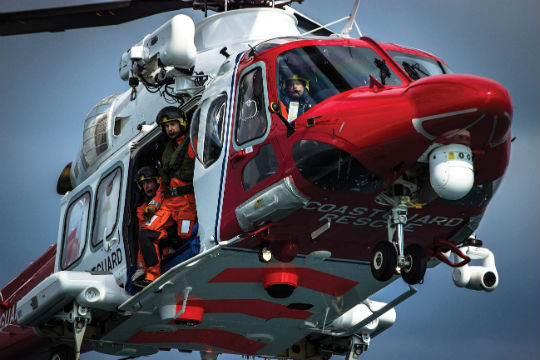
The standard crew configuration remains the same as when the service was provided by the Royal Navy and Royal Air Force: two pilots, a winch operator, and a winchman. Royal Navy Photo
A multi-camera pod underneath the aircraft holds a low-light camera, a daylight camera, and a forward looking infrared camera; these are joined by a small tail camera and a camera on the hoist (a Goodrich dual electric hoist, for full redundancy). The hoist camera provides much of the footage that gets released to the media following rescues, but can also be viewed in real-time by the pilots. “It gives you a bit of heightened situational awareness,” said pilot James Lorraine. “If you’ve got a winchman or stretcher on the line and a spin starts, you can see it immediately.”
The aircraft also carries a Skyshout loudspeaker system and a Trakkabeam A800 searchlight. While the aircraft is fully compatible with night vision goggles (NVGs) and the crews routinely use them for night operations, Lorraine said the searchlight could make a huge difference in the circumstances in which they could affect a rescue. “Working with night vision goggles is excellent, because it means you can get to places you couldn’t get to otherwise,” he said. “But in the end, the winching evolution — when you’re actually affecting the rescue — it’s much safer, much more comfortable, to do it with [the searchlight’s] white light.”
Inside the aircraft, the observer station (manned by either the winch operator or winchman) has the EuroNav 7 moving map and task management system, and controls the various systems in the camera pod, as well as the searchlight. The aircraft also contains a large auxiliary fuel tank that can carry 1,000 pounds (450 kilograms) of extra fuel.
In terms of its performance, the S-92 has a cruise speed of 145 knots, an operational radius in excess of 250 nautical miles, and a capacity of 21 people. (The AW189 also has a cruise of 145 knots, its operational range is in excess of 200 nautical miles, and it can carry 16 people.)
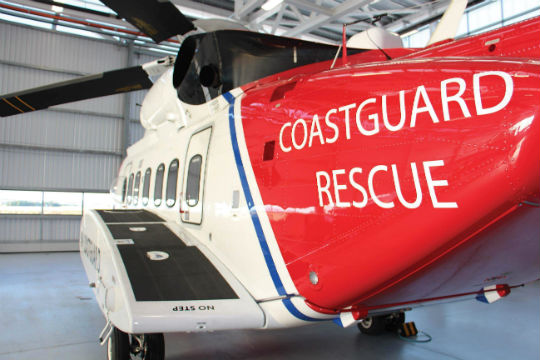
The bases have been extremely busy in their first months of operation, with Inverness alone recording more than 160 taskings in its first six months. Oliver Johnson Photo
Sheldon said the capability of the S-92 was broadly equivalent with the Sea King, but brings a number of significant enhancements. “It’s a fast aircraft,” he said. “The Sea King would cruise around 110 knots, whereas this aircraft is happy to cruise around 140, and certainly from my previous experience, it is noticeable now how quickly we get to different locations. It may sound like ‘only’ 30 knots, but it does make a big difference. We can now get to Ben Nevis within 25 minutes’ flying time, whereas from Lossiemouth it was more like 35/40 minutes.”
Another huge capability enhancement is the aircraft’s rotor ice protection, said Sheldon — something the Sea King didn’t have. “In the winter months in the Highlands of Scotland, you’re often operating in very cold weather conditions, and as soon as you start getting into snow or operating in reduced visibility because of cloud, then icing is a big issue for older aircraft like the Sea King,” he said. “The S-92 has got full rotor ice protection, which means essentially the icing problem disappears — it’s not a problem anymore. It will allow us to get to places faster, because we can just climb up into what was previously icing conditions, and fly straight lines.”
Sheldon said the range of the S-92 was about the same as the Sea King, but the newer aircraft’s greater speed meant that it would be able to complete a tasking much more quickly.
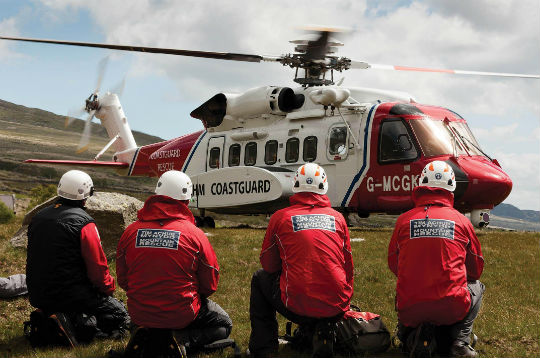
The bases have sought to quickly establish working relationships with local rescue crews. Here, the Caernarfon crew trains with the local mountain rescue service. Mike Gibson Photo
From the perspective of those working in the back, winch operator Chris Bodiam, who spent many years working in the same position in the RAF, said the speed and comfort of the S-92 were the major upgrades from the Sea King. “The two things I notice most are that the lighting in the cabin is fantastic — so when you’re operating at night, you can see what you’re doing when you’re working on the casualty without affecting the pilots — and the speed in which we get from A to B,” he said. “Those are the things that still leave me in awe every time we go out. It’s a phenomenal reduction in transit time. Because it’s a familiar area, I look out of my window expecting to be halfway, and we’re nearly there.”
Harnessing Experience
Each base is staffed with 30 people: nine pilots, 10 technical crew (five winch operators, five winchmen/paramedics); nine engineers; a storeman; and a base administrator. All of them live within a 30-mile radius of the base.
Willenbacher described the recruitment effort as a largely “traditional” application process, with certain experience requirements that applicants needed to meet, followed by a face-to-face interview, and finally aptitude testing in a simulator. “Then we looked not just at capability, but because these bases work as such a tight knit unit, a family almost, we also had to look at personalities and how people would fit in,” she said. And, as part of the managed transition from the military provision of SAR, Bristow committed to conducting interviews with all military SAR personnel who applied.
“It was quite a lengthy process, but we wanted to make sure that we had the right balance as well,” said Willenbacher. “We wanted to have a good representation from the Royal Air Force, from the Royal Navy, but then also recognizing the civilian side as well; because Bristow has been conducting SAR since 1971, there is a lot of SAR experience within Bristow that hasn’t been attained from the military. So, by doing that we’ve been able to cherry pick the best of all organizations, and make sure that we’ve got the right blend at each base.”

A Royal National Lifeboat Institution (RNLI) crew from Aith in the Shetland Islands trains with an S-92 during its service on the Gap SAR contract. Bristow Photo
While the selection process is complete, the military pilots and technical crew that are joining Bristow don’t actually transition over until their existing base closes. For example, the Royal Naval SAR base in Gannet (Prestwick) will close when Bristow opens its Prestwick location in January. Those military personnel in Gannet who are joining Bristow will begin their induction in January, and while they’re getting the transition training they need — whether it’s a type rating on the aircraft they’re going to fly, or working with the technical crew — Bristow has a designated transition team that will stand up the service. Then once the former military crews are qualified, they swap in.
“We called it a managed transition for exactly that — it had to be a very managed process,” said Willenbacher. “The feedback from the client, from the military at high levels, and from the military personnel who are transferring over, is that it’s been a success. These men and women are happy, they’re excited, they’re flying new technology at bases that are, for most of them, pretty close to where their families are. Finally they get to go home on a regular basis. For them it’s a great opportunity to have a really good work/life balance. So they’re ecstatic.”

The split between land and sea rescues varies by base. In Inverness, Sheldon estimated that about 80 percent of its taskings were either fully over land or coastal. Mike Gibson Photo
At the base level, Sheldon said the mix of Royal Navy, RAF, and civilian personnel has worked out well — with the new service working from an amalgam of the standard operating procedures from the three sources. “They’ve chosen the best bits from each organization, brought it together, and we’re all operating to that standard now,” he said. “The kind of ethos is the same, the desire to do the job as best we can is the same. There’s no difference in terms of wanting to provide a first class service, it’s very much there. And what’s good about this is we’ve got so many good people who’ve been drawn in from different organizations and we’re all working together exceptionally well. There’s no hostility, animosity, or anything like that; everyone is gelling together really well. It’s got a really positive feel about it; there’s a real buzz about the place.”
For Willenbacher, while the rollout of the service is a work in progress, the success of the program so far is in the numbers. “Within the first two months of Caenarfon’s go-live, they conducted 100 taskings — that’s hitting the ground running, from day one. Inverness got their first tasking within 50 minutes of going live. That demonstrates we are ready to go. And I cannot talk more highly of every single person that’s had a part to play in that. So I couldn’t be more pleased with where we are right now. We’ve still got a ways to go, but I’m extremely proud and very happy with what we’ve been able to accomplish.”









